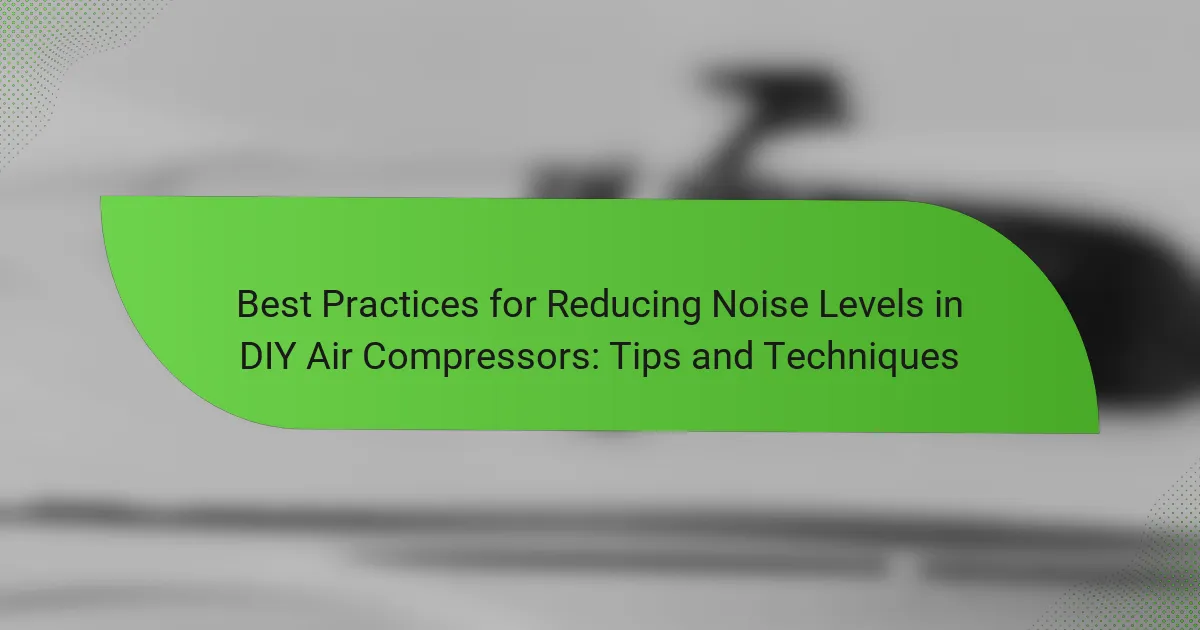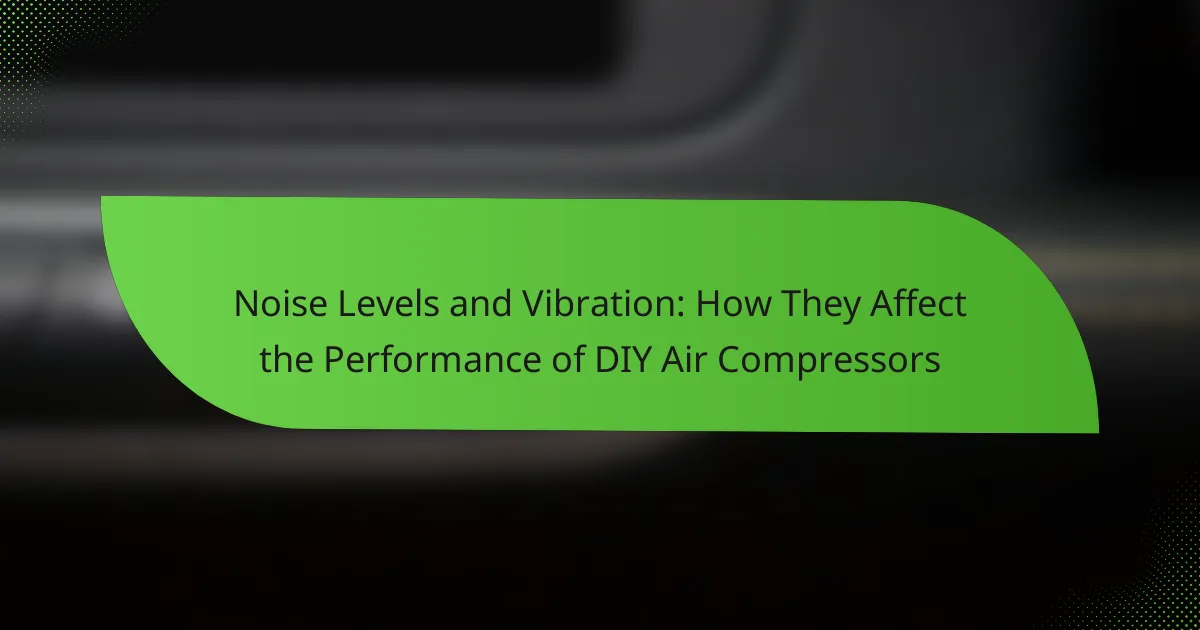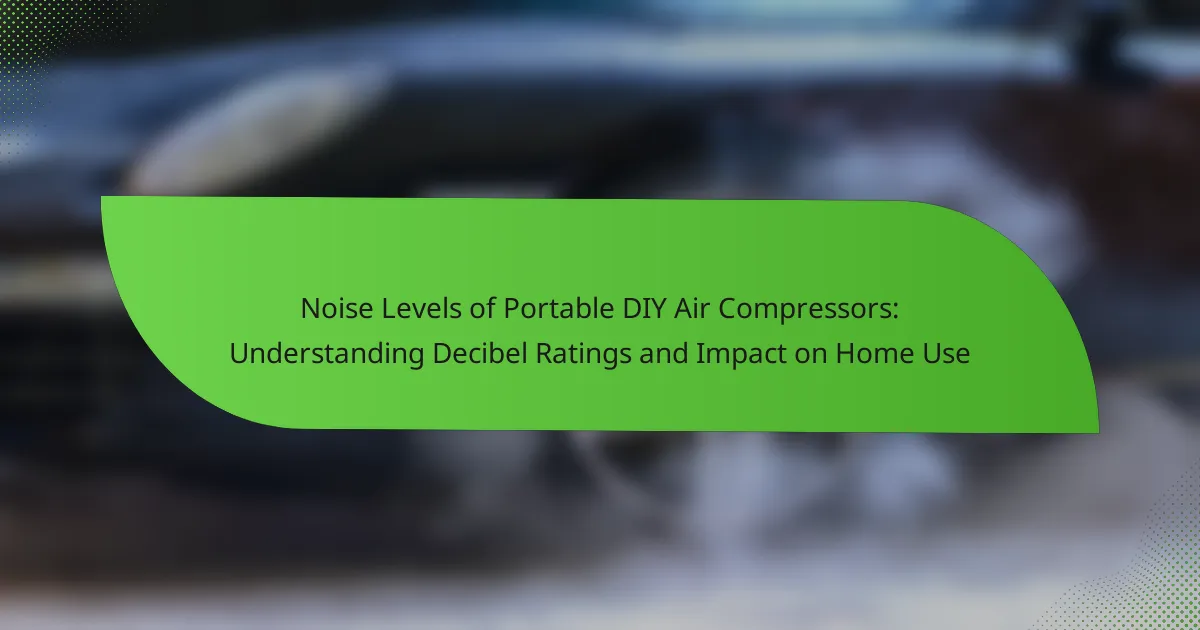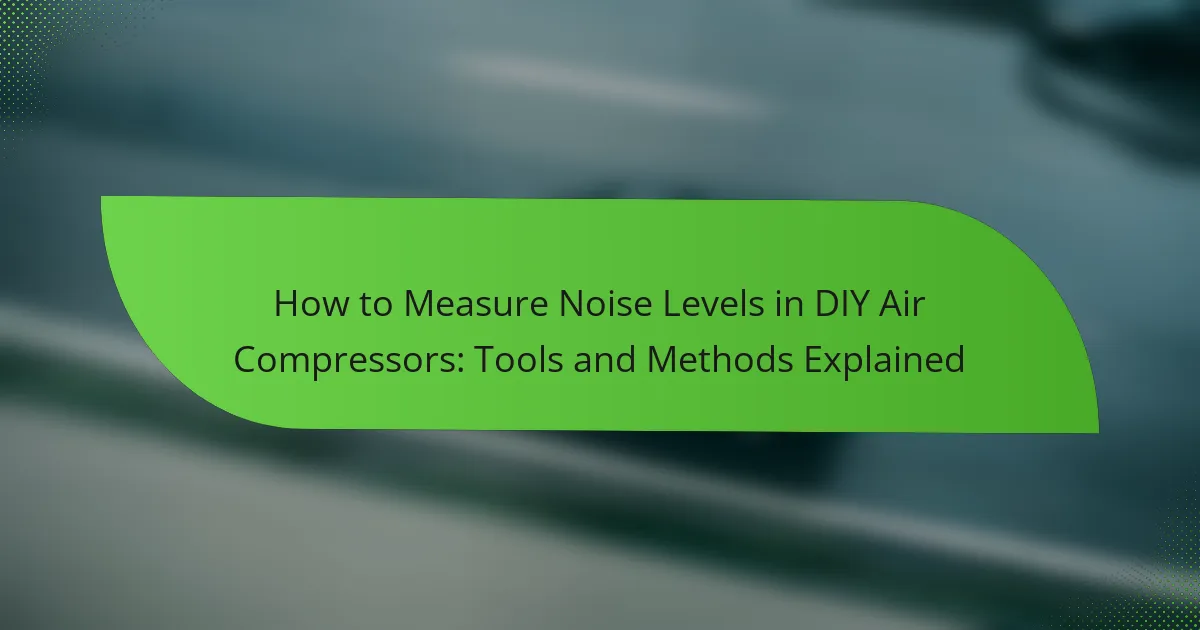Quiet DIY air compressors are specially designed to operate at low noise levels, making them suitable for home use and various DIY projects. These compressors typically utilize oil-free pumps or sound-dampening technologies, with many models generating noise levels below 60 decibels. Key factors to consider when selecting a quiet air compressor include noise level, tank size, power output, and portability features. Best practices for usage involve regular maintenance, appropriate pressure settings, and adherence to safety guidelines to ensure optimal performance and longevity. This article outlines the features and benefits of quiet DIY air compressors, providing essential information for effective selection and usage.
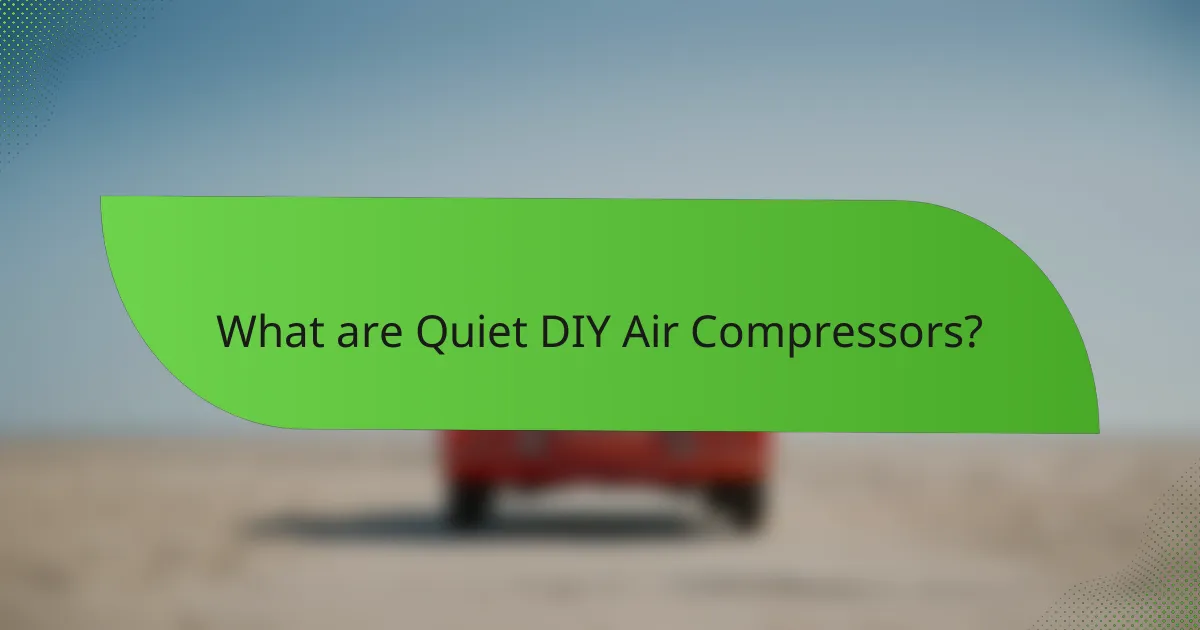
What are Quiet DIY Air Compressors?
Quiet DIY air compressors are air compressors designed to operate at reduced noise levels. They typically use oil-free pumps or sound-dampening technologies. These compressors are ideal for home use and DIY projects. Their low noise output makes them suitable for indoor environments. Many models operate below 60 decibels, which is quieter than standard compressors. This reduced noise level allows for comfortable use without disturbing others. Quiet DIY air compressors are also lightweight and portable, enhancing their usability. They provide efficient air pressure for various tasks such as inflating tires or powering tools.
How do Quiet DIY Air Compressors differ from traditional models?
Quiet DIY air compressors differ from traditional models primarily in their noise levels. Traditional air compressors often operate at 70 decibels or higher, while quiet models can function at around 50-60 decibels. This significant reduction in noise makes them more suitable for residential use or in environments where noise is a concern.
Quiet models typically utilize sound-dampening technology or enclosed designs to minimize sound output. Additionally, they may have slower pump speeds that contribute to reduced noise. These features allow users to work comfortably without the disruptive sounds associated with conventional compressors.
The demand for quieter operation has led manufacturers to innovate, resulting in models that maintain performance while prioritizing user comfort. As a result, quiet DIY air compressors are increasingly popular among hobbyists and professionals alike.
What noise levels are considered low for air compressors?
Noise levels below 70 decibels (dB) are considered low for air compressors. These levels are suitable for residential use and indoor environments. Compressors operating at 60 dB or lower are often deemed very quiet. For context, normal conversation is around 60 dB. Many low-noise models are designed to minimize sound output while maintaining performance. Manufacturers often specify noise levels in product descriptions to help consumers choose quieter options.
What technologies contribute to noise reduction in these compressors?
Technologies that contribute to noise reduction in compressors include sound insulation, vibration dampening, and advanced motor designs. Sound insulation involves using materials that absorb sound waves, reducing noise emissions. Vibration dampening technologies minimize the vibrations produced by the compressor, which are a primary source of noise. Advanced motor designs, such as brushless motors, operate more quietly than traditional motors. Additionally, variable speed drives can adjust the motor speed, leading to lower noise levels during operation. These technologies collectively enhance the quiet operation of air compressors, making them suitable for DIY projects in noise-sensitive environments.
What are the primary features of Quiet DIY Air Compressors?
Quiet DIY air compressors are designed to operate at lower noise levels compared to traditional models. These compressors typically feature a sound level of 60 decibels or less. They utilize oil-free pumps, which contribute to quieter operation and reduced maintenance. Many models also incorporate vibration-dampening technology to minimize noise during use. Additionally, quiet air compressors often have a compact design for easy storage and portability. They are suitable for indoor use, making them ideal for home projects. Many units come with multiple pressure settings for versatility. Quiet performance does not compromise efficiency, as these compressors can deliver adequate power for various tasks.
What types of compressors are available in low-noise models?
Low-noise models of compressors include rotary screw compressors, scroll compressors, and diaphragm compressors. Rotary screw compressors operate quietly due to their continuous operation and smooth airflow. Scroll compressors are known for their minimal noise levels and compact design. Diaphragm compressors produce low noise because they use a flexible diaphragm instead of traditional pistons. These types of compressors are designed for applications requiring quieter operation, making them ideal for residential and workshop use.
How do size and portability impact the use of Quiet DIY Air Compressors?
Size and portability significantly influence the use of Quiet DIY Air Compressors. Smaller, portable models are easier to transport and store. This convenience allows users to move the compressor between different work sites effortlessly. Compact designs often have lower weight, enhancing maneuverability. Additionally, these models can fit into tight spaces, making them suitable for home projects.
In contrast, larger compressors may offer higher power but can be cumbersome. Their size limits their usability in confined areas. Portability affects the frequency of use; more portable units are likely to be used more often. According to industry reports, users prefer compact models for DIY tasks due to their versatility and ease of handling.
What benefits do Quiet DIY Air Compressors provide for users?
Quiet DIY air compressors provide users with reduced noise levels during operation. This feature enhances the user experience by allowing for a more comfortable working environment. Users can work on projects without disturbing others nearby. Quiet models typically operate at sound levels below 60 decibels. This is significantly quieter than traditional air compressors. The low noise makes them suitable for indoor use. Additionally, quieter compressors often have vibration dampening features. This reduces wear and tear on the unit, increasing its lifespan. Overall, quiet DIY air compressors combine efficiency with user-friendly operation.
How do low-noise models enhance the user experience?
Low-noise models enhance the user experience by providing a quieter operational environment. This reduction in noise minimizes distractions during use. Users can focus better on their tasks without the interference of loud sounds. Low-noise models also promote a more comfortable working atmosphere. Extended use becomes more tolerable, reducing fatigue and stress. Additionally, these models are often designed for residential areas where noise restrictions apply. Users appreciate the ability to operate equipment without disturbing neighbors. Overall, low-noise models significantly improve satisfaction and usability for DIY projects.
What are the safety advantages of using Quiet DIY Air Compressors?
Quiet DIY air compressors offer several safety advantages. Their low noise levels reduce the risk of hearing damage for users. This is particularly important in prolonged usage scenarios where loud equipment can lead to auditory stress. Additionally, quieter models often feature enhanced vibration dampening. This minimizes the risk of accidents caused by unstable equipment during operation. Many quiet air compressors also come with built-in safety features. These include automatic shut-off systems that prevent overheating and pressure build-up. Such features contribute to safer operation compared to traditional, noisier models.
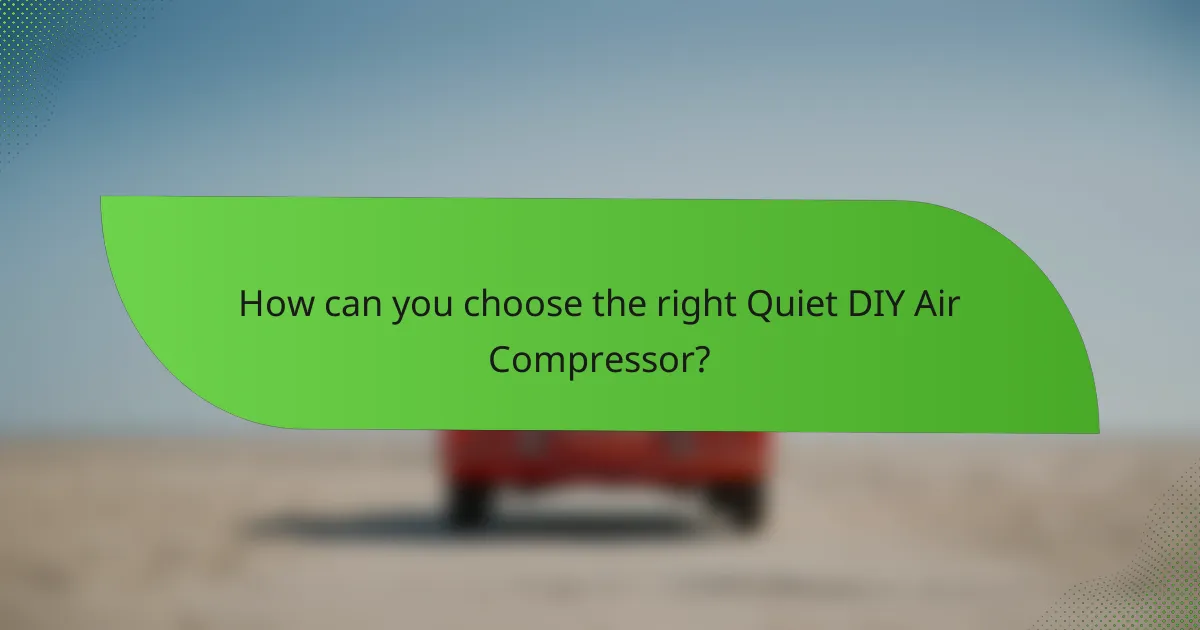
How can you choose the right Quiet DIY Air Compressor?
To choose the right Quiet DIY Air Compressor, assess its noise level, tank size, and power output. Look for models with a noise rating under 60 decibels for quieter operation. A larger tank, typically 6 gallons or more, provides longer run times between refills. Ensure the compressor has sufficient power, ideally at least 1.5 horsepower, for your intended tasks. Also, consider portability features like weight and handle design. Check customer reviews for real-world performance insights. Researching brands known for reliability can also guide your choice.
What factors should you consider when selecting a low-noise model?
When selecting a low-noise model, consider the decibel rating. A lower decibel rating indicates quieter operation. Look for models with sound insulation features. These can help reduce noise levels further. Evaluate the motor type, as some are inherently quieter. Oil-lubricated compressors typically operate more quietly than direct-drive models. Assess the tank size, as larger tanks can reduce the frequency of motor cycling. Finally, check customer reviews for real-world noise performance. Reviews can provide insights into how quiet the model truly is during operation.
How does power and capacity influence your choice?
Power and capacity directly influence the choice of quiet DIY air compressors. Higher power ratings typically allow for faster inflation and more efficient operation. A compressor’s capacity, measured in cubic feet per minute (CFM), determines its ability to supply air for various tasks. Choosing a model with adequate power ensures it can handle demanding applications without overheating. Additionally, sufficient capacity allows for simultaneous use of multiple tools or longer operation times. For example, a compressor with a 2.5 CFM rating can efficiently power a brad nailer or tire inflator. Therefore, selecting the right balance of power and capacity is crucial for optimal performance and user satisfaction.
What maintenance requirements should you be aware of?
Regular maintenance is essential for quiet DIY air compressors. Check and change the oil as per the manufacturer’s guidelines. Inspect the air filter and clean or replace it to ensure optimal airflow. Drain the moisture from the tank to prevent rust and corrosion. Tighten any loose bolts or fittings to maintain integrity. Inspect hoses and connections for wear and replace them if damaged. Schedule periodic professional servicing to ensure all components function correctly. Following these maintenance steps can extend the lifespan of the compressor and enhance performance.
What are the common applications for Quiet DIY Air Compressors?
Quiet DIY air compressors are commonly used for tasks requiring low noise levels. These applications include inflating tires, powering air tools, and spraying paint. They are also effective for cleaning delicate electronics and operating airbrushes. Additionally, quiet air compressors serve well in home workshops and for hobby projects. Their low noise output makes them ideal for residential areas. Many users appreciate their ability to operate without disturbing others. Overall, quiet DIY air compressors are versatile tools for various tasks.
How do these compressors benefit home improvement projects?
Quiet DIY air compressors enhance home improvement projects by providing efficient power for various tools. They enable users to operate pneumatic tools like nail guns and spray guns effectively. Their low noise levels make them suitable for residential areas, reducing disturbance during projects. Many models are portable, allowing easy transport between job sites. They also offer consistent air pressure, improving the quality of work. Additionally, these compressors often feature energy-efficient designs, lowering electricity costs. Reliability is key, as many models are built for durability and long-term use. Overall, quiet DIY air compressors are invaluable for achieving professional results in home improvement tasks.
In what ways can Quiet DIY Air Compressors be used in professional settings?
Quiet DIY air compressors can be utilized in professional settings for various applications. They are ideal for tasks that require minimal noise disruption, such as indoor painting or woodworking. These compressors can power pneumatic tools like nail guns and spray guns efficiently. Their low noise levels help maintain a conducive work environment, especially in residential areas or offices. Additionally, they can be used for inflating tires and sports equipment without causing disturbances. Their compact size allows for easy transport and storage in workshops. Quiet DIY air compressors also enhance productivity by allowing continuous operation without the stress of loud sounds.
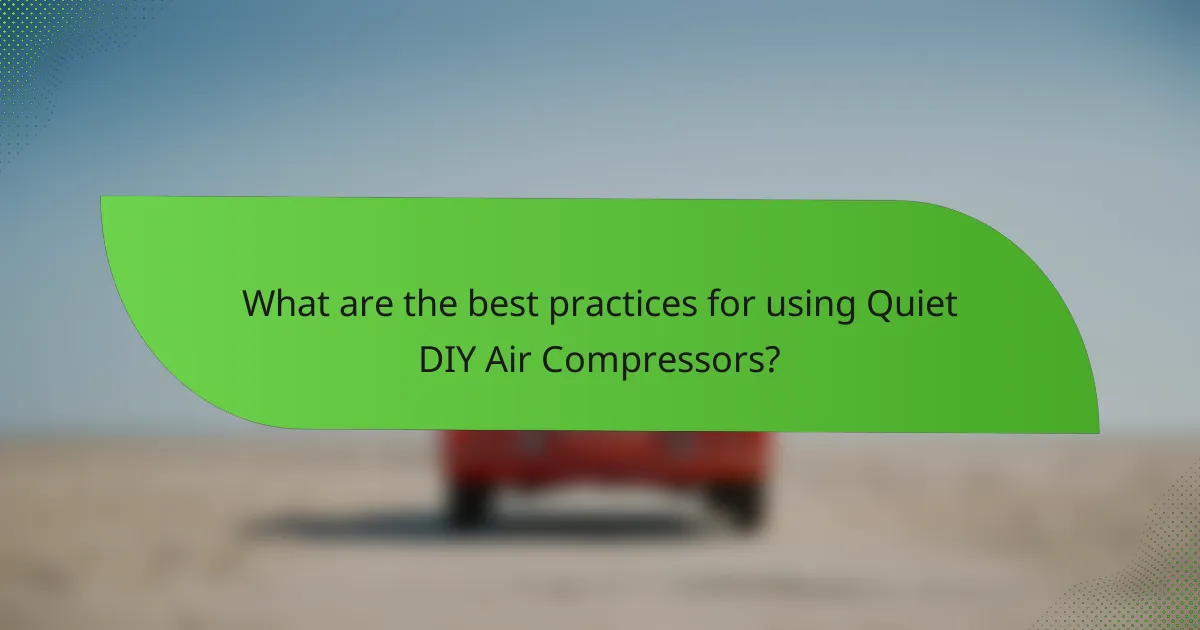
What are the best practices for using Quiet DIY Air Compressors?
The best practices for using Quiet DIY Air Compressors include proper maintenance, correct pressure settings, and safe operation. Regularly check and change the oil to ensure optimal performance. Keep the air filter clean to maintain airflow efficiency. Set the pressure according to the tool requirements for effective operation. Use appropriate hoses and fittings to prevent leaks. Always operate the compressor in a well-ventilated area to avoid overheating. Follow safety guidelines, including wearing protective gear. Ensure the compressor is on a stable surface to prevent tipping. These practices enhance the lifespan and performance of the compressor.
How can you ensure optimal performance from your compressor?
To ensure optimal performance from your compressor, perform regular maintenance. Regularly check and change the oil as needed. Clean or replace air filters to maintain airflow. Inspect hoses for leaks or damage to prevent pressure loss. Ensure proper lubrication of moving parts to reduce friction. Monitor the compressor’s temperature to prevent overheating. Follow the manufacturer’s guidelines for usage and load limits. These practices can extend the lifespan and efficiency of your compressor.
What are some tips for maintaining low noise levels during operation?
To maintain low noise levels during operation, use sound-dampening materials. Insulating the compressor with acoustic panels can significantly reduce noise. Additionally, placing the compressor on a vibration-absorbing mat minimizes vibrations that contribute to sound. Regular maintenance, such as lubricating moving parts, can also help decrease noise levels. Moreover, operating the compressor at lower pressure settings reduces the intensity of noise produced. Selecting a model designed for quiet operation, like those with enclosed motors, can further enhance noise reduction. Research shows that sound-dampening measures can lower operational noise by up to 50%.
What troubleshooting tips can help with Quiet DIY Air Compressors?
Check the power source to ensure the compressor is receiving electricity. Inspect the power cord for any damage or loose connections. Verify that the circuit breaker is not tripped. Examine the air filter for clogs and clean or replace it as needed. Ensure that the compressor’s tank is not overfilled, which can cause pressure issues. Listen for unusual noises that may indicate mechanical problems. Tighten any loose bolts or fittings that could lead to air leaks. If the compressor does not start, the motor may be faulty and require professional assessment.
How can you identify and resolve common issues?
Identify common issues by observing performance and listening for unusual noises. Check for air leaks in hoses and fittings. Inspect the power supply for any interruptions. Monitor pressure levels to ensure they meet specifications. If the compressor is overheating, verify that it has adequate ventilation. Resolve these issues by tightening connections, replacing faulty parts, or adjusting settings. Regular maintenance can prevent many problems. Following the manufacturer’s guidelines enhances longevity and efficiency.
What steps should you take if your compressor is louder than expected?
Check the compressor’s mounting. Ensure it is securely fastened. Loose mounting can amplify noise. Inspect the air intake filter. A dirty filter can cause the compressor to work harder, increasing noise levels. Clean or replace the filter if necessary. Examine the compressor for any loose components. Tighten any screws or bolts that may be loose. Listen for unusual sounds. Grinding or rattling may indicate internal issues. If the noise persists, consult the manufacturer’s manual. It may provide specific troubleshooting steps. If needed, contact a professional for further diagnosis.
Quiet DIY air compressors are specialized air compressors designed for low noise operation, typically functioning below 60 decibels. This article explores their unique features, including sound-dampening technologies, portability, and efficiency for various tasks such as inflating tires and powering tools. Key comparisons with traditional models highlight their quieter performance and user-friendly design, making them suitable for home and professional use. The article also covers essential aspects like maintenance, safety advantages, and best practices for optimal performance, providing a comprehensive overview of quiet air compressor applications and benefits.
